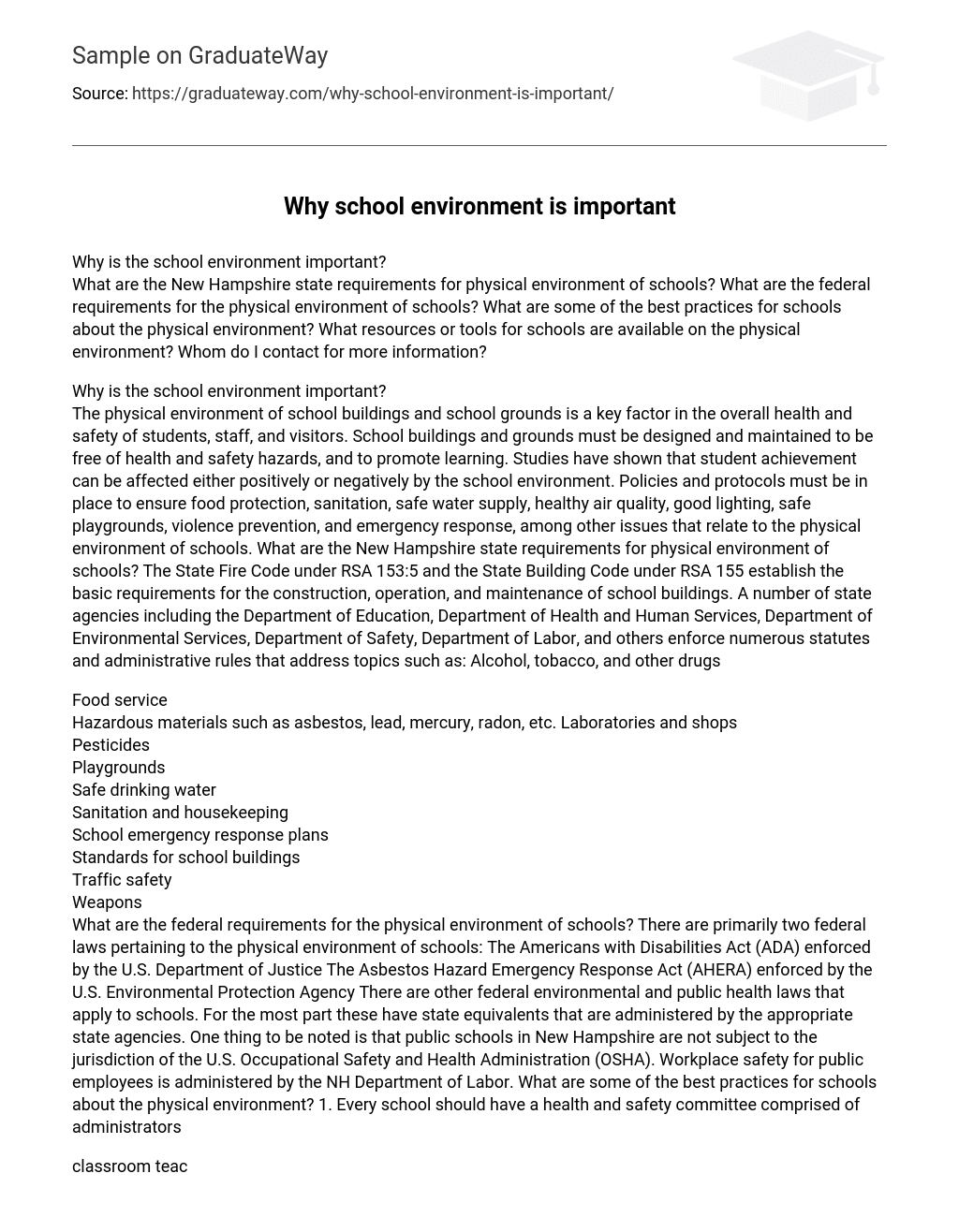Why is the school environment important?
What are the New Hampshire state requirements for physical environment of schools? What are the federal requirements for the physical environment of schools? What are some of the best practices for schools about the physical environment? What resources or tools for schools are available on the physical environment? Whom do I contact for more information?
Why is the school environment important?
The physical environment of school buildings and school grounds is a key factor in the overall health and safety of students, staff, and visitors. School buildings and grounds must be designed and maintained to be free of health and safety hazards, and to promote learning. Studies have shown that student achievement can be affected either positively or negatively by the school environment. Policies and protocols must be in place to ensure food protection, sanitation, safe water supply, healthy air quality, good lighting, safe playgrounds, violence prevention, and emergency response, among other issues that relate to the physical environment of schools. What are the New Hampshire state requirements for physical environment of schools? The State Fire Code under RSA 153:5 and the State Building Code under RSA 155 establish the basic requirements for the construction, operation, and maintenance of school buildings. A number of state agencies including the Department of Education, Department of Health and Human Services, Department of Environmental Services, Department of Safety, Department of Labor, and others enforce numerous statutes and administrative rules that address topics such as: Alcohol, tobacco, and other drugs
Food service
Hazardous materials such as asbestos, lead, mercury, radon, etc. Laboratories and shops
Pesticides
Playgrounds
Safe drinking water
Sanitation and housekeeping
School emergency response plans
Standards for school buildings
Traffic safety
Weapons
What are the federal requirements for the physical environment of schools? There are primarily two federal laws pertaining to the physical environment of schools: The Americans with Disabilities Act (ADA) enforced by the U.S. Department of Justice The Asbestos Hazard Emergency Response Act (AHERA) enforced by the U.S. Environmental Protection Agency There are other federal environmental and public health laws that apply to schools. For the most part these have state equivalents that are administered by the appropriate state agencies. One thing to be noted is that public schools in New Hampshire are not subject to the jurisdiction of the U.S. Occupational Safety and Health Administration (OSHA). Workplace safety for public employees is administered by the NH Department of Labor. What are some of the best practices for schools about the physical environment? 1. Every school should have a health and safety committee comprised of administrators
classroom teachers
parents
maintenance personnel
school nurse
industrial arts, studio art, and family and consumer science teachers laboratory science teachers
food service personnel
school resource officer
The committee should develop and ensure the implementation of plans for safe, healthy and well-maintained school buildings and grounds. The committee should be empowered to deal with on-going maintenance and repair issues, as well as on-going and emerging health or safety issues related to the physical environment of schools and school grounds. 2. Every school should practice emergency response drills for a variety of likely hazards and situations. 3. Schools should implement programs to maintain good indoor air quality such as the EPA’s Tools for Schools program. 4. School maintenance staff should practice Integrated Pest Management (IPM) and cleaning for health also known as green cleaning. 5. Schools should use automated systems such as Healthy SEAT and/or a Computerized Maintenance Management System (CMMS) to record and analyze maintenance issues and trends. This may be done at the district level. 6. Schools should establish procedures for managing chemicals used in science classes to include storage, reordering, and disposal.





